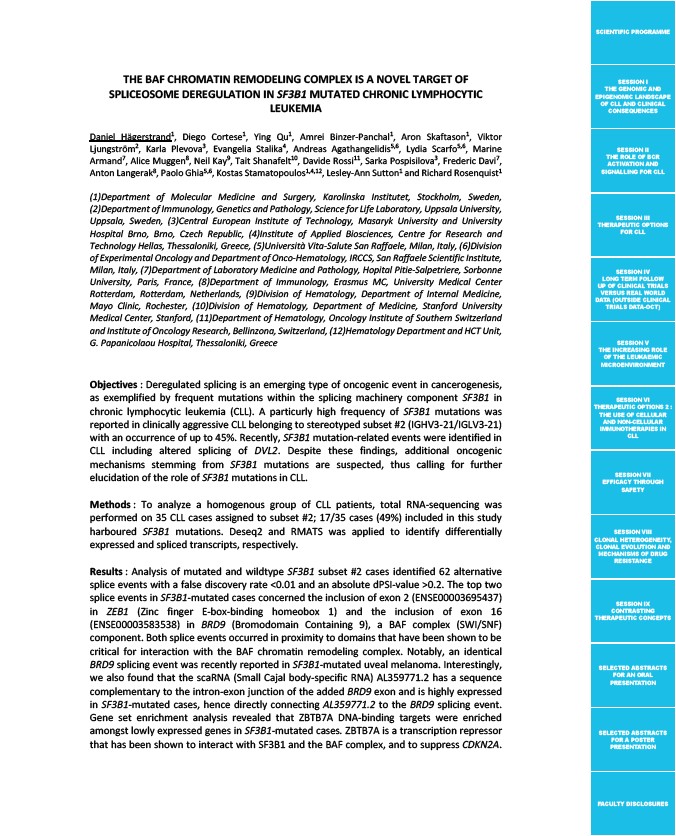
SCIENTIFIC PROGRAMME
SESSION I
THE GENOMIC AND
EPIGENOMIC LANDSCAPE
OF CLL AND CLINICAL
CONSEQUENCES
SESSION II
THE ROLE OF BCR
ACTIVATION AND
SIGNALLING FOR CLL
SESSION III
THERAPEUTIC OPTIONS
FOR CLL
SESSION IV
LONG TERM FOLLOW
UP OF CLINICAL TRIALS
VERSUS REAL WORLD
DATA (OUTSIDE CLINICAL
TRIALS DATA-OCT)
SESSION V
THE INCREASING ROLE
OF THE LEUKAEMIC
MICROENVIRONMENT
SESSION VI
THERAPEUTIC OPTIONS 2 :
THE USE OF CELLULAR
AND NON-CELLULAR
IMMUNOTHERAPIES IN
CLL
SESSION VII
EFFICACY THROUGH
SAFETY
SESSION VIII
CLONAL HETEROGENEITY,
CLONAL EVOLUTION AND
MECHANISMS OF DRUG
RESISTANCE
SESSION IX
CONTRASTING
THERAPEUTIC CONCEPTS
SELECTED ABSTRACTS
FOR AN ORAL
PRESENTATION
SELECTED ABSTRACTS
FOR A POSTER
PRESENTATION
FACULTY DISCLOSURES
THE BAF CHROMATIN REMODELING COMPLEX IS A NOVEL TARGET OF
SPLICEOSOME DEREGULATION IN SF3B1 MUTATED CHRONIC LYMPHOCYTIC
LEUKEMIA
Daniel Hägerstrand1, Diego Cortese1, Ying Qu1, Amrei Binzer-Panchal1, Aron Skaftason1, Viktor
Ljungström2, Karla Plevova3, Evangelia Stalika4, Andreas Agathangelidis5,6, Lydia Scarfo5,6, Marine
Armand7, Alice Muggen8, Neil Kay9, Tait Shanafelt10, Davide Rossi11, Sarka Pospisilova3, Frederic Davi7,
Anton Langerak8, Paolo Ghia5,6, Kostas Stamatopoulos1,4,12, Lesley-Ann Sutton1 and Richard Rosenquist1
(1)Department of Molecular Medicine and Surgery, Karolinska Institutet, Stockholm, Sweden,
(2)Department of Immunology, Genetics and Pathology, Science for Life Laboratory, Uppsala University,
Uppsala, Sweden, (3)Central European Institute of Technology, Masaryk University and University
Hospital Brno, Brno, Czech Republic, (4)Institute of Applied Biosciences, Centre for Research and
Technology Hellas, Thessaloniki, Greece, (5)Università Vita-Salute San Raffaele, Milan, Italy, (6)Division
of Experimental Oncology and Department of Onco-Hematology, IRCCS, San Raffaele Scientific Institute,
Milan, Italy, (7)Department of Laboratory Medicine and Pathology, Hopital Pitie-Salpetriere, Sorbonne
University, Paris, France, (8)Department of Immunology, Erasmus MC, University Medical Center
Rotterdam, Rotterdam, Netherlands, (9)Division of Hematology, Department of Internal Medicine,
Mayo Clinic, Rochester, (10)Division of Hematology, Department of Medicine, Stanford University
Medical Center, Stanford, (11)Department of Hematology, Oncology Institute of Southern Switzerland
and Institute of Oncology Research, Bellinzona, Switzerland, (12)Hematology Department and HCT Unit,
G. Papanicolaou Hospital, Thessaloniki, Greece
Objectives : Deregulated splicing is an emerging type of oncogenic event in cancerogenesis,
as exemplified by frequent mutations within the splicing machinery component SF3B1 in
chronic lymphocytic leukemia (CLL). A particurly high frequency of SF3B1 mutations was
reported in clinically aggressive CLL belonging to stereotyped subset #2 (IGHV3-21/IGLV3-21)
with an occurrence of up to 45%. Recently, SF3B1 mutation-related events were identified in
CLL including altered splicing of DVL2. Despite these findings, additional oncogenic
mechanisms stemming from SF3B1 mutations are suspected, thus calling for further
elucidation of the role of SF3B1 mutations in CLL.
Methods : To analyze a homogenous group of CLL patients, total RNA-sequencing was
performed on 35 CLL cases assigned to subset #2; 17/35 cases (49%) included in this study
harboured SF3B1 mutations. Deseq2 and RMATS was applied to identify differentially
expressed and spliced transcripts, respectively.
Results : Analysis of mutated and wildtype SF3B1 subset #2 cases identified 62 alternative
splice events with a false discovery rate <0.01 and an absolute dPSI-value >0.2. The top two
splice events in SF3B1-mutated cases concerned the inclusion of exon 2 (ENSE00003695437)
in ZEB1 (Zinc finger E-box-binding homeobox 1) and the inclusion of exon 16
(ENSE00003583538) in BRD9 (Bromodomain Containing 9), a BAF complex (SWI/SNF)
component. Both splice events occurred in proximity to domains that have been shown to be
critical for interaction with the BAF chromatin remodeling complex. Notably, an identical
BRD9 splicing event was recently reported in SF3B1-mutated uveal melanoma. Interestingly,
we also found that the scaRNA (Small Cajal body-specific RNA) AL359771.2 has a sequence
complementary to the intron-exon junction of the added BRD9 exon and is highly expressed
in SF3B1-mutated cases, hence directly connecting AL359771.2 to the BRD9 splicing event.
Gene set enrichment analysis revealed that ZBTB7A DNA-binding targets were enriched
amongst lowly expressed genes in SF3B1-mutated cases. ZBTB7A is a transcription repressor
that has been shown to interact with SF3B1 and the BAF complex, and to suppress CDKN2A.